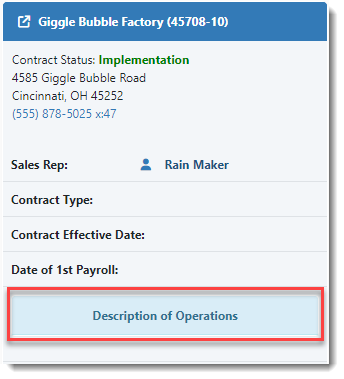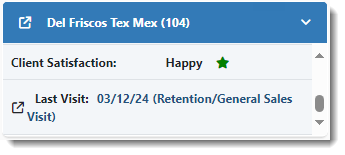Client Master Breakdown
In this topic, we define the major components of the Client Master dataform.
Header
The header displays the Client Name, Client Number in parentheses, and displays toolbar buttons.

Default Widgets
The default, "out of the box" configuration of the Client Master displays four (4) widgets at the top of the form:
-
Client Alert
-
Client Info
-
Required Forms
-
Client Contacts
Widgets can be added, removed, or rearranged on any dataform by a user with Global Administrator access. See Adding Widget Layouts.
Client Alert
The Client Alert widget displays text entered in the Client Alerts field of the Client Master dataform as a banner at the top of the Client Master Dataform.
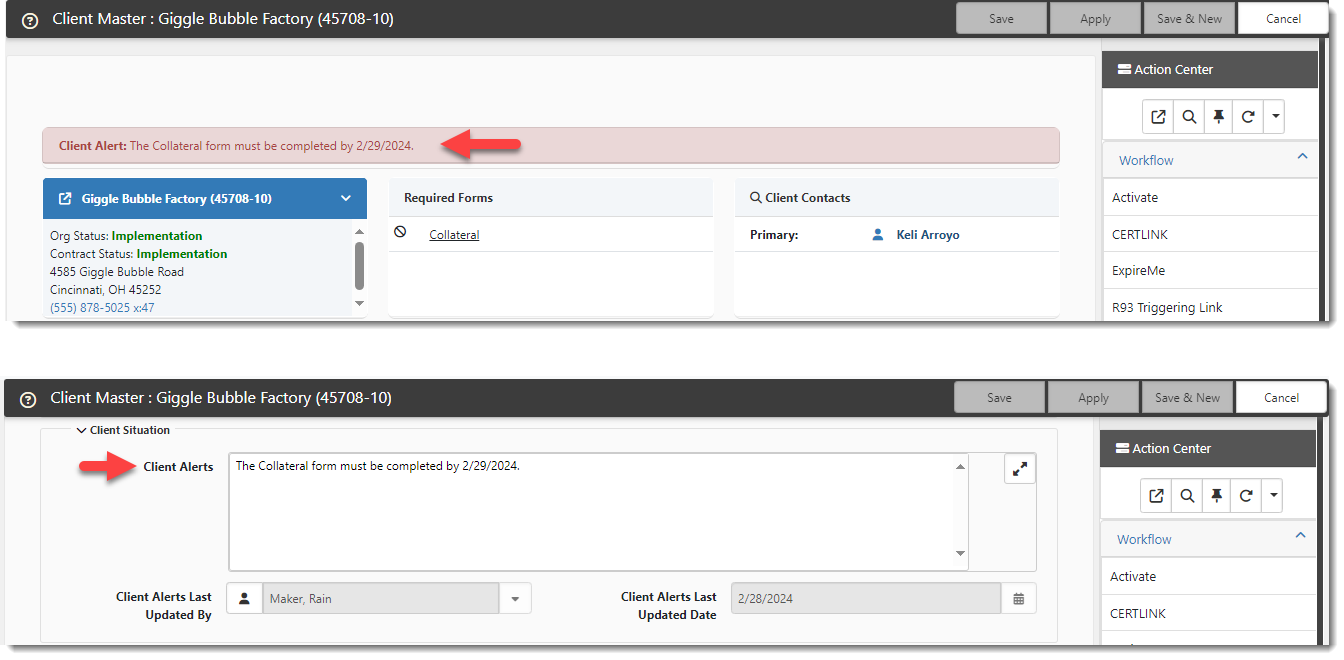
Note: Although the text that displays on the Client Alert banner is added and maintained on the Client Master dataform, the widget is frequently added to other dataforms including the Client Service Case, Client Visits, Workspace landing page, and others.
Also seeLearning how: Client Alerts.
Client Info
The Client Info widget displays a client information snapshot. Basic information such as the Org Status and Contract Status is displayed as well as a company address and phone number.
Note: Org Status and Contract Status values may vary depending on whether your company uses the ClientSpace CORE and Sales modules or ClientSpace CORE only. For instance, "CORE and Sales" users may see Implementation, Client, Pending Termination, and Termination. "CORE only" users may see all of the aforementioned statuses except the Implementation status.
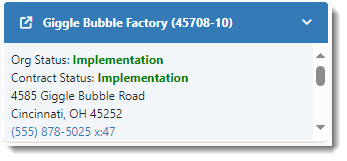
If you click the down arrow in the widget header, you can also see additional information such as the Sales Representative's name, a View link to the Service Agreement (if uploaded), the client satisfaction level, and the date of the last client visit.
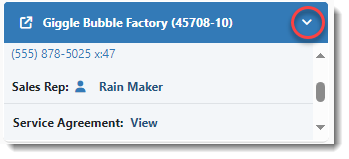
Note:
-
Depending on the dimensions of the widget (set in the widget layout), you may have to scroll within the widget to see the additional fields after clicking the down arrow.
-
Client satisfaction in the widget is only populated if the Satisfaction Level field (which is typically located in the Client Situation fieldset of the Client Master) is populated.
Required Forms
The Required Forms widget displays a list of client forms that must be completed. A green check mark displays next to completed forms.
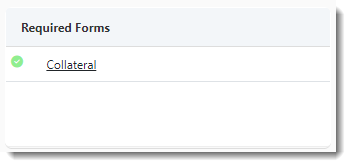
Also see What makes a dataform required?
Client Contacts
The Client Contacts widget displays the contacts associated with the organization. By default, only the Primary Contact displays. You can set the kinds of other contacts that display on Client Contacts widget in the widget settings. See Configuring the Client Contacts widget.

If you click the down arrow in the widget header, you can view additional contacts.

Note: Depending on the dimensions of the widget (set in the widget layout), you may have to scroll within the widget to see the additional contacts after clicking the down arrow.
Fieldsets
In this section, we define the fields by fieldset![]() Dataform fieldsets are descriptive bounding boxes used to group sets of data on dataforms together. Fieldsets can be nested within each other, as well as dynamically hidden or displayed based on trigger values. Dynamically hiding a fieldset hides all of the fields within it. Field requirement is negated when a field is hidden. for fields located on the Client Master dataform, with exception of any custom fields that were set up specifically for your company.
Dataform fieldsets are descriptive bounding boxes used to group sets of data on dataforms together. Fieldsets can be nested within each other, as well as dynamically hidden or displayed based on trigger values. Dynamically hiding a fieldset hides all of the fields within it. Field requirement is negated when a field is hidden. for fields located on the Client Master dataform, with exception of any custom fields that were set up specifically for your company.
Note:
-
The order and placement of fieldsets and fields may vary depending on configuration.
-
All fieldsets, even if they are not custom fields, may not be present on the Client Master dataform for your company. The fieldsets that display depend on the modules and features of ClientSpace that your company uses.
-
Fieldsets on ClientSpace dataforms, including the Client Master, can be expanded to display all fields or collapsed to hide fields. See Adding Dataform Fields.
About Client Master Tabs
Whether or not the Client Master displays as a multi-tabbed window depends on your configuration. For instance, there may only be a single page of fields with no additional tabs displayed:
Or, if ClientSpace is configured to use our Recurring Client Visits feature, for instance, the primary fields may display on a Home tab (![]() ) and there may also be a Company Other Info tab containing fields for tracking client visits as depicted in the example below:
) and there may also be a Company Other Info tab containing fields for tracking client visits as depicted in the example below:
Also see Configuring Recurring Visits.
Alternatively, the primary fields may display on a Home tab (![]() ) as in the previous example and there could also be one or more custom secondary tabs containing fields that were requested by your company to support your business needs. In the example below, an Implementation Details tab has been added to the Client Master to capture client implementation information:
) as in the previous example and there could also be one or more custom secondary tabs containing fields that were requested by your company to support your business needs. In the example below, an Implementation Details tab has been added to the Client Master to capture client implementation information:
Primary (or Home  Tab) Fields
Tab) Fields
Company Information
Note: Changes made on the Client Master record to any Organization record fields used to populate this section are recorded in the Organization's Audit Trail (which is accessed by clicking the Magnifying Glass ![]() icon in the Action Center toolbar.) The Current User ID is recorded as the Updated By User ID in the Audit Trail.
icon in the Action Center toolbar.) The Current User ID is recorded as the Updated By User ID in the Audit Trail.
| Legal Name |
Legal name of the company. Note:
|
|
DBA |
Name the organization is currently "doing business as". |
| Sales Rep | Salesperson who onboarded the client. |
|
FEIN |
The Federal Employer Identification Number (FEIN) is used to identify an employer for tax administration purposes. |
| Business Type | Used to briefly describe the business. EX: Hospitality. Business Type is selected from a drop down list. |
| Source |
Indicates how the lead for this client originated. EX: Referral. Source is selected from a customizable drop down list. |
|
Website |
The URL of the organization website. |
| Phone |
The phone number for the organization. From here, you can click |
| Fax |
The fax number for the organization. From here, you can click |
| NAICS |
North American Industry Classification System (NAICS) is a standard 6 digit code used to classify businesses by Federal agencies who collect, analyze, and publish statistical data related to the U.S. economy. To find an NAICS code, go to https://www.naics.com/search/. You can also type the Wildcard (% ) Search |
| Address 1, Address 2 |
Organization address. Address 2 is used for additional data such as a Suite #. |
| City, State, Postal Code, County | Organization city, state, postal code, and county. If you add the Client Master record from an Organization record, these fields are auto-filled from the Organization record. If you add this information manually, upon entering the Postal Code, the City, County, and State are populated. |
Additional Company Information
| Corporation Type |
A corporation is a company or group of people authorized to act as a single entity (legally a person) and recognized as such in law. The corporation type is specified here. EX: C Corp or S Corp. Corporation Type is selected from a drop down list. |
| Date of Incorporation | The date the company was legally formed. |
|
SIC Code |
The Standard Industrial Classification (SIC) code is a 4 digit numeric business classification code that categorizes an industry based on the company's business activities. |
|
Parent Company |
A company that controls or is controlled by another company, often one that is in the same business group. |
|
Description of Operations |
A text field used to enter a brief description of an organization's business operations. This description also displays when you click the Description of Operations button on the Client Info 2 widget. Note: The Client Info 2 widget is an extended version of the Client Info widget that includes a few additional fields such as Date of First Payroll and Description of Operations. This widget is commonly used on workspace landing page widget layouts. |
|
WC Deductible |
This field was added to support the Claim Deductible Billing process and only displays if ClientSpace is configured for that feature. The WC Deductible is used in Claim Deductible Billing calculations. The system checks to the WC Deductible against the total claim financials amount of a claim to determine the amount of the Claim Deductible Bill. See Configuration and Process Overview of the Claim Deductible Billing Process. |
|
WC Deductible Bill Opt-Out |
This field was added to support the Claim Deductible Billing process and only displays if ClientSpace is configured for that feature. When checked, the WC Deductible Bill Opt-Out setting excludes a client from claim deductible bill processing. To be included for claim deductible billing, Claim Deductible Billing records must be in "Ready to Bill" status and the WC Deductible Bill Opt-Out setting on the Client Master record of each associated client workspace must be unchecked. See Configuration and Process Overview of the Claim Deductible Billing Process.
Note: Both the WC Deductible and the WC Deductible Bill Opt-Out fields are for use with the ClientSpace Risk module only. |
Sales/Broker Information
| Sales Region |
Used to identify the geographical area or segment of customers assigned to a Sales representative or broker. These list options are customized to how you define regions. EX: A region could be defined as a state (i.e., Florida) or a part of the United States (i.e., Northeastern US). Note: There is an optional business rule named Update Template From Sales Region which sets a workspace template for associated Client Master client when the Sales Region field value is updated. The business rule checks the sales region and metadata specified on the SalesRegionMetadata dataform. If the sales region is selected and the metadata points to a different workspace than the one currently in use, the system will update the workspace template. The template change updates the users, security, and dataforms associated with the workspace to match that of the new template. If the template specified in the metadata is not different, or no template is configured in the Sales Region metadata, template and workspace configuration will not change |
| Broker Submitted | Indicates that the client prospect was obtained and submitted by an external intermediary, not an internal sales representative. |
| Primary Broker |
A Primary Broker is the PEO Broker. This is an intermediary who specializes in connecting businesses with PEOs. The Primary Broker is added to ClientSpace as an organization record. Then, the Primary Agents are added as contacts to this organization record. Select a Primary Broker here and then select the Primary Agent (see below) associated with the selected broker. |
| Primary Agent |
Select the Primary Agent (i.e., broker representative) associated with the selected Primary Broker (see above). |
| Locked |
Indicates whether an associated Request for Proposal (RFP) (i.e., initial pricing or repricing for existing clients) is locked to prevent further updates. The Locked checkbox is only displayed and set if RFP locking is configured and enabled in the ClientSpace Pricing module. This field is used in conjunction with Lock Expiration Date. Note: If a "Kill" workflow process is initiated on an RFP from the Pricing Console or Client Master record, the Locked checkbox is unchecked and the Locked Expiration Date is also cleared. The Client Master record and all associated underwriting approval records are set to a Status of "Dead". (The Status field is typically located in the Workflow Information fieldset). All associated underwriting approval records are marked Inactive (i.e., the Active checkbox is cleared) and the Audit field of each underwriting approval record is updated with the status change details. |
| Lock Expiration Date |
The Lock Expiration Date is set based on the configured RFP lock duration. Note: The Locked and Lock Expiration Date fields are for use with the ClientSpace Pricing module only. |
Contract Information
| Secondary ID |
The Secondary ID is only used if a client has a multi-tenant environment (i.e., multiple PrismHR databases connected to a single ClientSpace installation.) This ID represents the instance of a client's PrismHR database. |
|
Legal Entity |
In the PEO space, the legal entity is the registered business entity of your client in the PEO co-relationship and is tied to paying federal taxes as well as unemployment filing. Note: If you use the Pricing Console and you do not identify a legal entity on the Client Master record, ClientSpace use the default legal entity associated with the Contract Type for pricing. |
|
Client Number |
The Client Number is a primary ID representing the instance of a client's PrismHR database.
Note: In a multi-tenant environment, the Client Number may not be unique for all PrismHR database installations being accessed via a single instance of ClientSpace, the Client Number is combined with the Secondary ID to ensure a unique identifier called the Import ID. The Import ID ensures that ClientSpace logs into the correct PrismHR database instance for imports and exports. |
|
Contract Type |
A classification describing the contract. EX: PEO, ASO, HRO, Staffing, etc. Contract Type is selected from a customizable drop down list. |
|
Pay Frequency |
How often the client pays its employees. EX: Weekly, Bi-Weekly, Monthly, etc. |
|
Contract Effective Date |
Date the contract became effective. |
|
Date of First Payroll |
Date of first payroll run by the client after entering the co-employment relationship. |
|
Tax Exempt |
Checkbox used to identify whether the client is recognized by the IRS as tax-exempt status based on an allowed organization type such as a church, nonprofit hospital or labor union, humane society, art museum, etc. |
|
Signed Contract |
An upload field used to attached the signed contract. |
|
Payroll System |
Used to identify the Payroll system that the client uses. EX: PrismHR, Summit, etc. Payroll System is selected from a customizable drop down list. |
|
Contract Remarks |
Used to add important notes or comments about the contract. |
Client Situation
|
Satisfaction Level |
Select a customer satisfaction level from a drop down list. The display value is customizable and links back to a three-star "customer temperature" rating system that is used to populate the Client Satisfaction field of in the Client Info widget. In the example below, a display value of Happy has been associated with the green star rating: Conventionally, a green star rating is used to indicate a very satisfied to satisfied customer, while a yellow or gold star indicates a moderately satisfied to neutral customer and a red star indicates a dissatisfied customer in need of attention. However, these colors can be customized in the Client Satisfaction lookup configuration. Note:
|
|
Alert Notes |
The Client Alert widget displays text entered in the Client Alerts field of the Client Master dataform as a banner at the top of the Client Master Dataform. |
|
Alert Updated By |
System-generated user stamp that occurs on Apply or Save. Indicates the username of the individual who entered the alert. |
|
Alert Updated Date |
System-generated date stamp that occurs on Apply or Save. Indicate the time alert was applied. |
OSHA
| Generate OSHA 300A ITA |
When checked, the OSHA 300A ITA merge is run when the yearly scheduled process Generate OSHA Forms runs. The resulting file attachment is added to the OSHA Forms dataform of the associated workspace in the OSHA 300A ITA field. |
|
Generate OSHA 300/301 ITS |
When checked, the OSHA 300/301 ITA merge is run when the yearly scheduled process Generate OSHA Forms runs. The resulting file attachment is added to the OSHA Forms dataform of the associated workspace in the OSHA 300/301 ITA field. |
Workflow Information
Depending on your configuration, some of these field such as Status, date fields and Kill Reason may appear dimmed and unavailable. This typically indicates that the field data was imported from another application, such as Salesforce, via an API or is part of an automatic sales workflow.
| Status | The client status. EX: Client, Pending Termination, Terminated, etc. |
| Status Date | The date the current Status was applied. |
| Create Date | The date the underwriting approval record was created. |
| Submit Date | The date the underwriting approval record was submitted. |
|
Underwriting Approval Date |
The date the underwriting approval record was marked Approved. |
|
Implementation Start Date |
The date client onboarding began. |
|
Activation Date |
Date of ClientSpace activation. |
|
Pricing Renewal Date |
Date the pricing renewal batch was created. |
|
Kill Reason |
If a "Kill" workflow process was initiated on an RFP from the Pricing Console or Client Master record, you can specify a reason for RFP termination by selecting from a custom list of options here. This value may also import from another application, such as Salesforce, via an API. |
|
Sync with PrismHR (Import) |
This initiates a manual, one-time only sync from PrismHR. When checked, a scheduled process imports the client's Employee, Employment, Location, and Client Team data from PrismHR. This option is frequently used to import client data that failed to import due to errors that occurred during the initial import. Once the one-time sync is complete, the flag is automatically unchecked by the system. Note: The client must have a Client Number to use this feature. |
Company Other Info Tab Fields
Recurring Client Visit Schedule
These fields are only displayed if your company is configured to use the Recurring Client Visits feature. With recurring visit, when you mark a visit Completed, a new planned visit is automatically set up on the Client Visit dashboard. This feature requires configuration. For more information, see Configuring Recurring Visits.
| Visit fields (field labels may vary) |
The names of the visit fields displayed here can vary depending on configuration. You may have one general visit field or you may have multiple. EX: HR General Visit, WC Safety Visit, etc. This selection in this field informs the system when to schedule the next planned visit. Using the example visit types listed above, if you select Annually for the HR General Visit category, once an HR General Visit is marked complete, a planned visit is added to the Client Visit dashboard for next year. Similarly, if you select Quarterly for the WC Safety Visit category, similarly, once a visit is marked complete in the current quarter, a new planned visit is added for the next quarter. |



